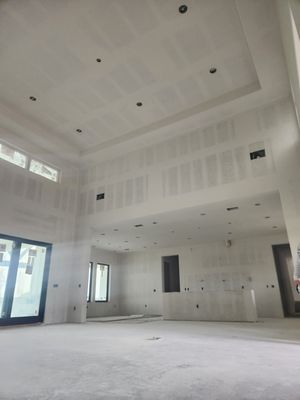When you’re working on drywall in your home, you’ll often hear the term ‘taped and mudded’ used, especially when it comes to aesthetics and meeting fire protection codes. But what exactly do ‘mudding’ and ‘taping’ mean?
Taping refers to the process of applying a paper or fiberglass mesh tape over the joints between sheets of drywall. This tape helps to reinforce the joints and prevent cracks from forming over time.
Mudding involves applying joint compound, also known as mud, over the taped joints. This compound fills in gaps, smooths out the surface, and creates a seamless appearance between the drywall sheets.
So, when someone asks you what ‘taped and mudded’ means, you can tell them that it refers to the process of applying tape over the joints and then smoothing joint compound over it to achieve a finished, uniform surface on your drywall.
What Does it Mean if a Drywall is Taped and Mudded?

Ever wondered what it means when a wall is “taped and mudded”? Despite their unappealing names, taping and mudding are essential steps in the drywall finishing process. It involves carefully taping the joints where drywall sheets meet, followed by applying layers of “mud” (drywall compound). Between each layer, the mud dries, is sanded smooth, and repeated as needed.
These steps aren’t just for looks. They also make the drywall smooth, safe, and resistant to fire. Additionally, drywall itself can be purchased with specific fire resistance ratings or layered for extra fire protection.
Tapping Drywall
Applying tape to your drywall helps to bond adjacent sheets together, ensuring continuity and reducing the risk of cracking due to movement. It’s crucial to apply tape to prevent the joint compound from turning into powder.
In cases where there’s expected to be significant movement, such as in problematic areas, using drywall mesh may be necessary. However, this is more expensive and harder to smooth out compared to paper tape.
When taping, it’s important to avoid tape bubbles. Use paper drywall tape with air-drying joint compound, while self-sticking fiberglass tape is best used with setting compounds (which cure through a chemical reaction rather than air-drying).
Drywall Mudding
“Mud” refers to drywall joint compound, which is used to strengthen and smooth both the drywall and the joints between them. For your drywall project, you can use either dry or premixed mud. “All-purpose” mud is best for the base coat, while lightweight “topping” mud is ideal for the final, finishing coat.
The first coat of mudding compound acts like glue to secure the joint tape that seals together the drywall sheets. Subsequent coats of mud smooth over the tape, nail holes, small holes and other imperfections. Between coats, you’ll need to sand the mudded walls.
After taping and mudding the drywall, the final steps include applying texture (if desired) and painting.
Get Professional Drywall Services in Your Local Area
All ROA Drywall representatives are experienced professionals in drywall work. We ensure that your home or business location meets local fire codes and passes inspections. Contact ROA Drywall near you to request our services, or give us a call for assistance in your home or business.